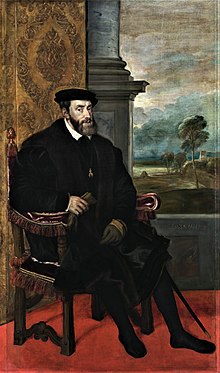
Back Cuius regio, eius religio Breton Cuius regio, eius religio Czech Cuius regio, eius religio Danish Cuius regio, eius religio German Kies reganto, ties religio Esperanto Cuius regio, eius religio Spanish Cuius regio, eius religio Finnish Cujus regio, ejus religio French Cuius regio, eius religio ID Cuius regio, eius religio Italian
This article's tone or style may not reflect the encyclopedic tone used on Wikipedia. (February 2024) |

Cuius regio, eius religio (Ecclesiastical Latin: [ˈku.jus ˈre.d͡ʒi.o ˈe.jus reˈli.d͡ʒi.o]) is a Latin phrase which literally means "whose realm, his religion" – meaning that the religion of the ruler was to dictate the religion of those ruled. This legal principle marked a major development in the collective (if not individual) freedom of religion within Western civilization. Before tolerance of individual religious divergences became accepted, most statesmen and political theorists took it for granted that religious diversity was wrong and/or weakened a state[1] – and particularly weakened ecclesiastically-transmitted control and monitoring in a state.[2] The principle of "cuius regio" was a compromise in the conflict between this paradigm of statecraft and the emerging trend toward religious pluralism (coexistence within a single territory) developing throughout the German-speaking lands of the Holy Roman Empire. It permitted assortative migration of adherents to two religious groups, Roman Catholic and Lutheran, eliding other confessions.
At the Peace of Augsburg of 1555, which ended a period of armed conflict between Roman Catholic and Protestant forces within the Holy Roman Empire, the rulers of the German-speaking states and the Holy Roman Emperor, Charles V, agreed to accept this principle.
- ^
Finkelman, Paul (2 November 2012). "Toleration and Diversity in New Netherland and the Duke's Colony: the roots of America's first disestablishment". In Gunn, T. Jeremy; Witte, John (eds.). No Establishment of Religion: America's Original Contribution to Religious Liberty. Oxford: Oxford University Press (published 2012). ISBN 9780199986019. Retrieved 17 November 2019.
At the beginning of the seventeenth century ... virtually all European political leaders accepted the idea that religious diversity was dangerous to the stability of any government. ... Political leaders and political theorists alike assumed that religious difference would inevitably lead to internal social conflict or even civil war and anarchy. The brutal wars of the sixteenth century certainly reinforced this idea. ... Religious diversity among Christians was simply too dangerous for most jurisdictions.
- ^
Karp, Alan (January 1985). "John Calvin and the Geneva Academy: Roots of the Board of Trustees". History of Higher Education Annual. Vol. 5. Transaction Publishers (published 1985). p. 12. ISBN 9781412825283. Retrieved 17 November 2019.
The conception of the church as the spiritual arm of the temporal authority was in accord with the Reformation view of the proper relationship between church and state.
During the Middle Ages society was considered a universal whole governed by God through the papal vice-regency. ... The Reformation brought the medieval unity to an end and replaced it with the Augsburg formula of religious compromise, cuius regio eius religio.